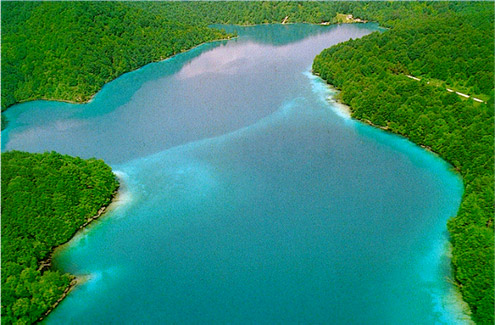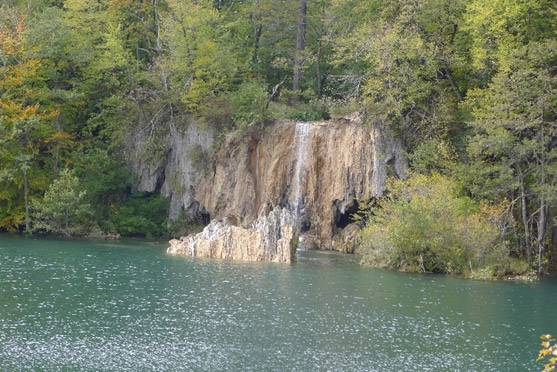Age and growth of the tufa barriers
The process of tufa formation dates way back into the geological past, but only during periods with a warm and wet climate, similar to the climate today. The age of the active tufa barriers has been estimated at between 6,000 and 7,000 years, which corresponds to the theory that they began to grow following the end of the last Ice Age. Along the sides of the present day watercourses, palaeobarriers have been discovered at higher elevations, particularly at the most upstream parts of the lakes. Dating analyses have shown that they range in age from 250,000 to 300,000 years (Mindel-Riss interglacial period) and 90,000 – 130,000 years (Riss – Wurm interglacial period).

Submerged tufa barrier within Kozjak Lake (photo: PLNP archive)
Analysis of the ages of the active barriers and lake sediments have shown that the annual rate of deposition of lake sediment is about 17 times less than the rate of growth of the tufa barriers (about 13.5 mm), which results in a growth in lake water levels. Recent analyses applying hydrological methods have calculated that the exit barrier of Kozjak Lake is growing at an annual rate of about 5.6 mm, while the barrier at Prošćansko jezero Lake is growing three times faster. Each barrier has its own growth dynamics, some grow faster, other slower. In some cases the downstream barrier grows faster than the upstream barrier, submerging the upstream barrier, and making two previously separated lakes into one.
An example of these dynamics if the sunken barrier in Kozjak Lake. About 400 years ago, Kozjak Lake was divided into two lakes, separated by a tufa barrier and a waterfall about 40 metres high. However, the tufa barrier at the outflow of Kozjak Lake (at Kozjački mostovi) grew much faster than the barrier that separated these two lakes. This resulted in a raising of the water level in the lake, gradually covering the waterfall, and causing the barrier to become submerged. This brought the two lakes into the one we see today.
The growth and development of the tufa barriers is threatened by changes to the physicochemical and biological factors that play a role in the tufa building process. Due to its fragile structure, tufa is vulnerable to mechanical damage and large dynamic loads. These tufa barriers are often threatened due to changes in the water regime, which can result in the barriers drying out, which will stop their growth. Barriers can also break due to trees falling on them, or due to melting ice in the spring period.

A broken off piece of the travertine barrier Ciginovac/Okrugljak (photo: PLNP archive)

